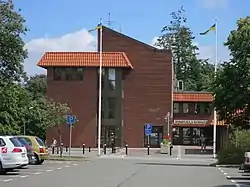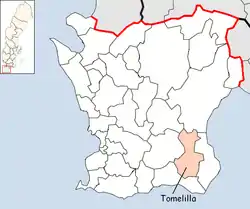Tomelilla Municipality
Tomelilla Municipality (Tomelilla kommun) is a municipality in Skåne County in southern Sweden. Its seat is located in the town Tomelilla.
Tomelilla Municipality
Tomelilla kommun | |
|---|---|
 Tomelilla City Hall | |
 Coat of arms | |
 | |
| Country | Sweden |
| County | Skåne County |
| Seat | Tomelilla |
| Area | |
| • Total | 397.39 km2 (153.43 sq mi) |
| • Land | 395.94 km2 (152.87 sq mi) |
| • Water | 1.45 km2 (0.56 sq mi) |
| Area as of 1 January 2014. | |
| Population (31 December 2019)[2] | |
| • Total | 13,617 |
| • Density | 34/km2 (89/sq mi) |
| Time zone | UTC+1 (CET) |
| • Summer (DST) | UTC+2 (CEST) |
| ISO 3166 code | SE |
| Province | Scania |
| Municipal code | 1270 |
| Website | www.tomelilla.se |
The municipality was formed through a series of amalgamations taking place in 1952, 1969 and 1971. The number of pre-1952 units making up the present municipality is twenty.
Geography
Tomelilla Municipality is located in the south-eastern plains of Scania known as Österlen, which is an area notable for its beauty, and thus popular among painters as well as covered with summer cottages, country mansions, and so on.
Localities
There were seven localities in the municipality in 2018.[3]
| Locality | Population |
|---|---|
| Tomelilla | 7,139 |
| Brösarp | 734 |
| Onslunda | 499 |
| Smedstorp | 377 |
| Lunnarp | 345 |
| Skåne-Tranås | 226 |
| Spjutstorp | 200 |
Notability
Tomelilla Municipality was made famous by Tage Danielsson (1928–1985) and Hans Alfredsson (1931-), who directed and acted in numerous movies that were filmed in and around the town of Tomelilla:
- The Apple War (1972)
- Ägget är löst (1975)
- Picassos äventyr (1978)
- Den enfaldige mördaren (1982)
- P&B (1983)
- Jim & piraterna Blom (1986)
If it wasn't for these movies and their popularity, Tomelilla would not have been more than a spot on the map. Quite a few famous people today own houses in the countryside surrounding Tomelilla. To mention a few:
- Hans Alfredson (director/actor)
- Gösta Ekman (actor)
- Ulf Lundell (singer)
- Gudrun Schyman (politician)
Tomelilla Municipality is known for the amusement park Tosselilla Summer Park, quite possibly the most visited amusement park in the province, and the Hallamölla waterfall.
Its coat of arms is from 2002. It depicts the bird kite, native to the area, in silver on a red shield.
References
- "Statistiska centralbyrån, Kommunarealer den 1 januari 2014" (in Swedish). Statistics Sweden. 2014-01-01. Archived from the original (Microsoft Excel) on 2016-09-27. Retrieved 2014-04-18.
- "Folkmängd i riket, län och kommuner 31 december 2019" (in Swedish). Statistics Sweden. February 20, 2020. Retrieved February 20, 2020.
- "Folkmängd per tätort efter region och vart 5:e år" (in Swedish). Statistics Sweden. Retrieved 2019-08-07.
External links
| Wikimedia Commons has media related to Tomelilla Municipality. |